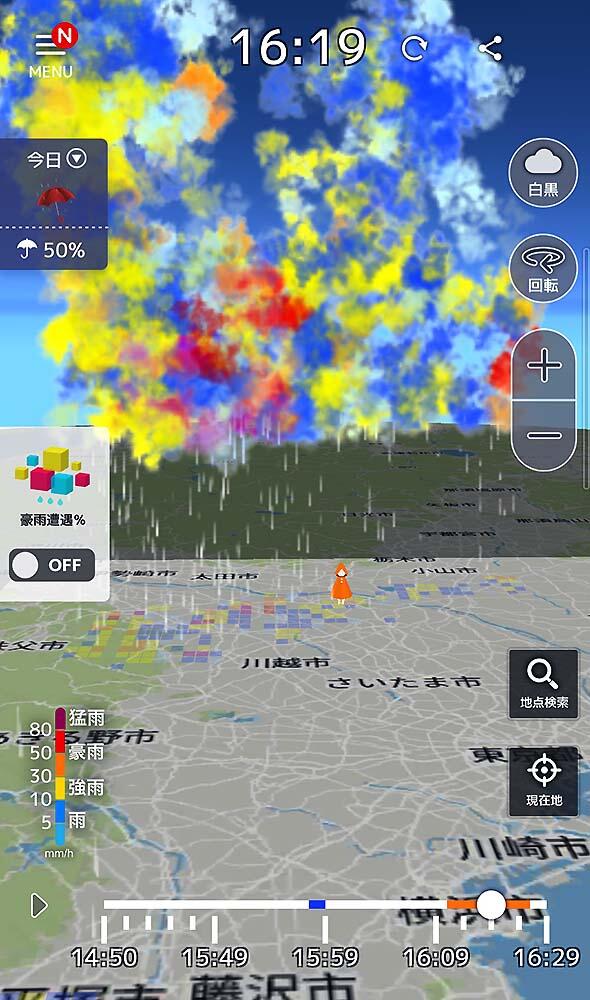A joint research group consisting of RIKEN, the National Institute of Informatics (NII), the National Institute of Information and Communications Technology (NICT), Osaka University, and MTI Ltd. used the cutting-edge "Fugaku" supercomputer to carry out real-time demonstrations of ultra-high speed and high-performance precipitation predictions, which consist of 30-second updates for 30 minutes. These demonstrations were held over two periods, from July 20 to August 8 and from August 24 to September 5. The "guerrilla rainstorm prediction method" used in these experiments is the first technology in the world that combines cyber simulations with actual real-world data collected from the state-of-the-art Multi-Parameter Phased Array Weather Radar (MP-PAWR) installed in Saitama City. The Fugaku supercomputer began to be used in this research from March 9, 2021 and the joint research group believes that the use of Fugaku is expected to greatly improve their research outcomes.
The joint research group consisted of Takemasa Miyoshi (Team Leader) and Arata Amemiya (Special Research Fellow), both from the Data Assimilation Research Team, RIKEN Center for Computational Science, Atsuya Uno (Unit Leader, System Operation Technology Unit, Operation Technology Division), Professor Yutaka Ishikawa (NII Architecture Science Research), Shinsuke Satoh (Chief Senior Researcher, Remote Sensing Laboratory, Radio Propagation Research Center, Radio Research Institute, NICT), Professor Tomoo Ushio (Graduate School of Engineering, Osaka University), and Kana Koike (Director of Meteorological Service Department, MTI Life Division).
In 2020, the group used observation data obtained from rain clouds every 30 seconds by the MP-PAWR (Saitama City) operated by NICT. This was in addition to the use of the state-of-the-art Joint Center for Advanced High Performance Computing (JCAHPC) supercomputer "Oakforest," which was jointly operated by Tsukuba University and the University of Tokyo, to collect and update data every 30 seconds, based on this data, a demonstration experiment was conducted in the Tokyo metropolitan area to predict the weather up to 30 minutes later. In this experiment, multiple simulations within the range of computational errors were performed. The experiment created an equally probable simulated parallel world and performed 50 ensemble calculations to express the variability (uncertainty) and ran 50 independent simulations in parallel.
When Fugaku was used in the follow up experiment, the group was able to achieve a 20-fold increase, performing 1000 ensemble calculations and executing 1000 independent simulations in parallel. This means that the prediction accuracy can be expected to improve.
In addition, by improving the entire system, weather forecasts with a resolution of 500 meters, updated every 30 seconds, can be implemented in real time. Upon comparing the results of this prediction technique with past observation data, the data was found to align with the distribution of the intense rain observed, facilitating the prediction of a guerilla rainstorm. This real-time forecast is the first of its kind in the world the demonstration experiment was the culmination of various achievements since October 2013, when this research first began.

Credit: MTI Ltd.
This was also the first attempt to use Fugaku in real time, and is expected to give rise to novel uses of Fugaku in the realization of a super-smart society "Society 5.0." The prognostic data obtained in this demonstration study were published on July 20 on RIKEN's webpage for prognostic weather research (https://weather.riken.jp/) and on MTI's smartphone app 3D Rain Cloud Watch (https://pawr.life-ranger.jp/), following approval based on the Meteorological Service Act. Nevertheless, these forecasts remain experimental in nature. Moreover, the researchers cannot ensure precise or stable delivery of information for practical use in meteorological predictions. This means that caution should be exercised, and this information is not suitable for use in decision-making related to user safety and interests.
■ Guerilla Rainstorm refers to a short, localized downpour of over 100mm of rain that often occurs in Japan.
This article has been translated by JST with permission from The Science News Ltd.(https://sci-news.co.jp/). Unauthorized reproduction of the article and photographs is prohibited.




